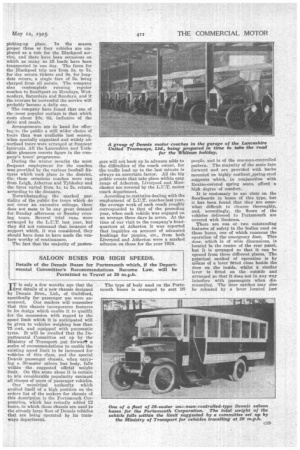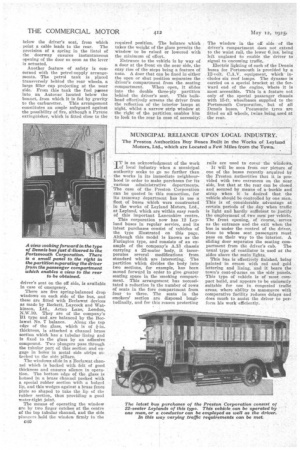SALOON BUSES FOR HIGH SPEEDS.
Page 23

Page 24

If you've noticed an error in this article please click here to report it so we can fix it.
Details of the Dennis Buses for Portsmouth which, if the Depart. mental Committee's Recommendations Become Law, will be Permitted to Travel at 20 in,p,h.
IT is only a few months ago that the first details of a new chassis designed by Dennis Bros., Ltd., of Guildford, specifically for passenger use were an. nounced. Our readers will remember that this chassis incorporates features in its design which enable it to qualify for the concession with regard to the speed limit which it is anticipated will be given to vehicles weighing less than 75 cwt. and equipped with pneumatic tyres. It will be recalled that the Departmental Committee set up by the Ministry of Transport put forwart a series of recommendations to enable the existing speed limit to be increased for vehicles of this class, and the special Dennis passenger chassis, when carrying a 30-seater saloon bus body, falls within the suggested official weight limit. On this score alone it is certain to win considerable popularity amongst all classes of users of passenger vehicles.
One municipal authority which availed itself of a high position on the orders list of the makers for chassis of this description is the Portsmouth Corporation, which has recently added 12 buses, in which these chassis are used to the already large fleet of Dennis vehicles that are being operated by its tramways department. The type of body used on the Portsmouth buses is arranged to seat 211
people, and is of the one-man-controlled pattern. The majority of the seats face forward and are provided with backs mounted on highly resilient.spring-steel supports which, in conjunction with Rexine-covered spring seats, afford a high degree of comfort.,
It is customary to Use slats on the floorboards in buses of this type, but it has been found that they are somewhat difficult to cleanse thoroughly, and, accordingly, the floors of the vehicles delivered to Portsmouth are covered with linoleum.
There are one or two outstanding features of safety in the bodies used on these buses, one of which concerns the operation of the emergency door. This , door, which is of wide dimensions, is located in the centre of the rear panel, but it is arranged so that it can be opened from three different places. The principal method of operation is by nigans of a lever fitted close beside the door on the inside, whilst a 'similar lever is fitted on the outside and arranged so that it does not in any way interfere with passengers when dismounting. The door catches may also be released by a lever located just
below the driver's seat, from which point a cable leads to the rear. The provision of a spring in the lintel of the doorway ensures instantaneous opening of the door so soon as the lever is actuated.
Another feature of safety is concerned with the petrol-supply arrangements. The petrol tank is placed transversely behind the rear wheels, a large filler cap projecting at the near side. From this tank the fuel passes into an Autovac located below the bonnet, from which it is fed by gravity to the carburetter. This arrangement constitutes an ample safeguard against the possibility of fire, although a Pyrene extinguisher, which is fitted close to the driver's seat on the off side, is available in case of emergency.
There are five spring-balanced drop 'windows on each side of the bus, and these are fitted with Beclawat devices as made by Beckett, Laycoek and Watkinson, Ltd., Acton Lane, London, N.W.10. They are of the company's 111 type and are balanced by the Bec
lawat No. 7 balance. Along the top edge of the glass, which is of i-in. thickness, is attached a channel brass section which has a tubular lining and is fixed to the glass by an adhesive compound. Two plungers pass through the tubular part of this section and engage in holes in metal side strips attt.elied to the side pillars.
The windows slide in a Beclawat channel which is backed with felt of good thickness and ensures silence in operation. The bottom edge of the glass is housed in a brass channel packed with a special rubber section with a bulged lip, and this wedges against a brass fence plate so shaped to take the lip of the rubber section, thus providing a good water-tight joint.
The means of operating the window are by two finger catches at the centre of the top tubular channel, and the side plungers hold the window firmly in the required position. The balance which takes the weight of the glass permits the window to be raised or lowered with the minimum of effort.
Entrance to the vehicle is by way of a door at the front on the near side, the easy rise of the step a being a feature of note. A door that can be fixed in either the open or shut position separates the driver's compartment from the seating compartment. When open, it slides into the double three-ply partition
behind the driver's seat. This bulkhead effectively screens the driver from the reflection of the interior lamps at night, whilst a narrow strip window at the right of the partition enables him to look to the rear in case of necessity:
The window in the off side of the driver's compartment does not extend to the waist rail, the lower kins, being left unglazed to enable the driver to signal to oncoming traffic.
Electric lighting of each of the Dennis buses for Portsmouth is provided by a 12-volt. C.A.V. equipment, which includes six roof lamps. The dynamo is carried on a special bracket at the forward end of the engine, where it is most accessible. This is a feature not only of the special passenger chassis with 15-ft. wheelbases supplied to the Portsmouth Corporation, but of all Dennis buses. Pneumatic tyres are fitted on all wheels, twins being used at the rear.
































